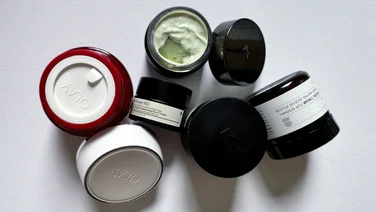To help us provide you with free impartial advice, we may earn a commission if you buy through links on our site. Learn more

Understanding your skin is the first step in taking better care of it and building an effective cleansing routine. There are three main skin types – normal, oily and dry – but many people have a combination of two of them (“combination skin”) with oily skin in some areas, typically the nose, and patches of dry skin elsewhere.
Skin types and skin conditions are different too, but many people often get these two confused. Don’t worry, we’ll explain everything you need to know in this article. So, let’s take a closer look at skin types and skin conditions and what you’ll need for the optimal skin care routine
Skin types & routines
Wondering what your skin type is? This is determined by characteristics like oil production, hydration levels and sensitivity; it’s usually heavily influenced by genetics, but your lifestyle, skincare routine and health can all play a part in it too.
Here’s what each skin type looks and feels like along with how to identify yours.
Normal skin
If your skin feels balanced, not too oily or dry, and you rarely experience breakouts, congratulations – you likely have normal skin. This means your skin is usually sufficiently hydrated without feeling greasy or shiny. It’s less prone to sensitivity or reactions to skincare products, but you might still experience occasional breakouts or dryness.
With normal skin, it’s about maintaining that delicate balance. Use a gentle daily cleanser, moisturiser and sun protection . If you have specific concerns, like hormonal breakouts for example, think about using a targeted treatment on those areas, like these products for treating acne outbreaks.
Oily skin
Oily skin tends to produce excess sebum (the skin’s natural oil), resulting in a shiny complexion and enlarged pores. If you have oily skin you might also be prone to acne and blackheads due to the increased oil production. You might also find that makeup doesn’t last as long as you would like because of the excess oil – but signs of ageing can also be slower to show up as a result.
For oily skin, avoid using harsh or drying products as these can actually strip your skin and damage its natural barrier, causing an overproduction of oil. Use oil-free cleansers and lightweight, non-comedogenic moisturisers. Remember, oily skin can still become dehydrated, so effective hydration is still hugely important.
READ NEXT: Best primers for oily skin
Dry skin
Dry skin has a lack of moisture (surprise, surprise), which often leads to a tight sensation and flakiness that might feel sore or sensitive. Those with this skin type may notice rough patches and fine lines, especially in areas that are prone to dryness. Dry skin can also show signs of premature ageing a little earlier too.
With dry skin, go for hydrating cleansers , rich moisturisers and products containing hyaluronic acid to keep your skin feeling plump and hydrated. Exfoliate gently to remove dry, flaky skin, as long as it’s comfortable for you.
READ NEXT: Best dry skin facial creams
Combination skin
Combination skin exhibits characteristics of more than one skin type together. It could be dry or normal in some areas while oily in others, typically the T-zone (forehead, nose and chin). Most people have this skin type, where you might notice your nose gets shiny and oily through the day but your cheeks stay feeling on the drier side.
This can mean you need to use products that are suitable for combination skin or that you may want to use skincare products that work for each different part of your face. Use a balanced cleanser, and consider spot treatments for specific concerns, like acne, in oilier regions.
What about sensitive skin and dehydrated skin?

You might be wondering where these classifications fit in. They’re not necessarily skin types in their own right, but are often caused by something in the environment. It’s important to note that these labels don’t change your genetic skin type, but affect how it looks and reacts.
Sensitive skin tends to react to the environment and skincare products, which can mean redness, itching, burning or discomfort when faced with weather changes, certain ingredients or harsh conditioners. Sensitive skin can be caused by genetics, underlying skin conditions or a compromised skin barrier. To help combat symptoms you should only use fragrance-free, gentle products in your skincare routine.
Dehydrated skin is a condition caused by a lack of water or moisture in the skin. It’s different to dry skin, which is caused by a lack of natural oil. Any skin type can become affected and if so, dehydrated skin will appear dull, feel tight and may show fine lines and wrinkles more prominently. The environment, weather and your skincare routine can all be factors. Thankfully dehydrated skin is only a temporary condition and can be managed by using a specific moisturiser for this problem.
READ NEXT: Best plumping face creams for mature skin
How to identify your skin type
If you’re trying to identify your skin type, here are some steps to take to work out what’s going on with your complexion and the products you might need to use.
1. Watch what your skin does throughout the day
Pay attention to how your skin feels in the morning, midday and evening. Note any changes in oiliness or dryness, especially after washing or using certain products.
2. Note your pore size
Examine your pores. If they look enlarged or you find they get blocked easily, especially in your T-zone, you may have oily or combination skin.
3. Check for sensitivity
Assess whether your skin reacts negatively to certain products, weather conditions or skincare routines. Dry skin, or skin that’s been compromised, can often feel more sensitive and irritated.
4. Examine hydration levels
Determine if your skin feels tight, flaky or plump and hydrated. Dryness can be a sign of dry skin, or a sign that something’s not working in your routine.
READ NEXT: Best night creams for every skin type
Is a skin type different to a skin condition?
Sometimes, people get their skin type confused with their skin condition (or mistake one for the other). Your skin type is the overall category your skin falls into – normal, oily, dry or combination – and is based on hydration, oil production and sensitivity, with each having distinct features that influence how it behaves.

On the other hand, a skin condition refers to specific issues or concerns that may affect the skin temporarily or chronically. Skin conditions can manifest as redness, inflammation, acne, eczema, psoriasis, hyperpigmentation and more.
Unlike skin type, which is relatively stable over time, skin conditions can vary and may be influenced by factors like genetics, lifestyle, hormonal changes and environmental exposure. Treating skin conditions often involves targeted products or medications designed to address specific symptoms or underlying causes.
What else can affect your skin?
As well as genetics, your environment, lifestyle choices, skincare routine and hormonal changes can all make a difference to the quality of your complexion.
Don’t underestimate the impact of harsh weather and extreme temperatures either. Ultraviolet (UV) radiation from the sun along with pollution and dirt in the atmosphere can all impact on the quality of your complexion.
What you eat and drink, how much sleep you get, smoking, drinking alcohol and sugar intake can all affect how your skin looks and feels. Some people might also be genetically prone to conditions like acne, rosacea or hyperpigmentation. Hormonal changes, like those during puberty, pregnancy or menopause, can also have a real impact.
Harsh skincare products, improper cleansing routines and over-exfoliation can cause problems too, disrupting the skin’s natural barrier, leading to irritation and sensitivity. Understanding which cleansing routine and products are best for your skin type (as described above) will keep your complexion feeling healthy and looking its best.






